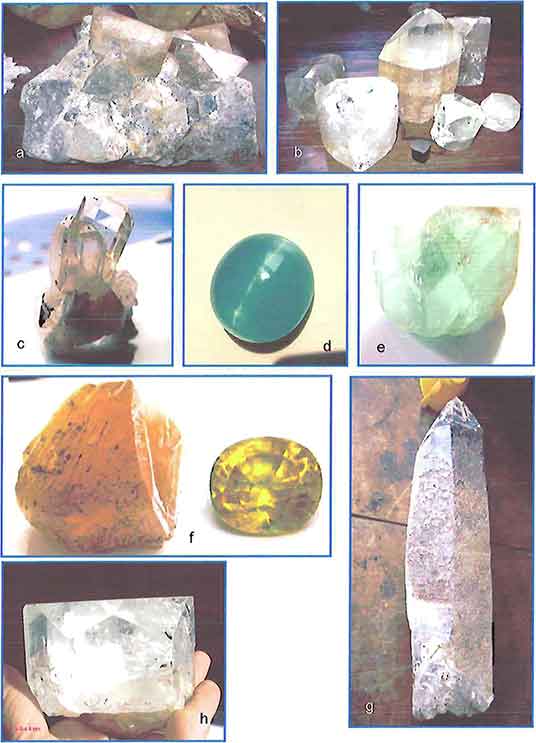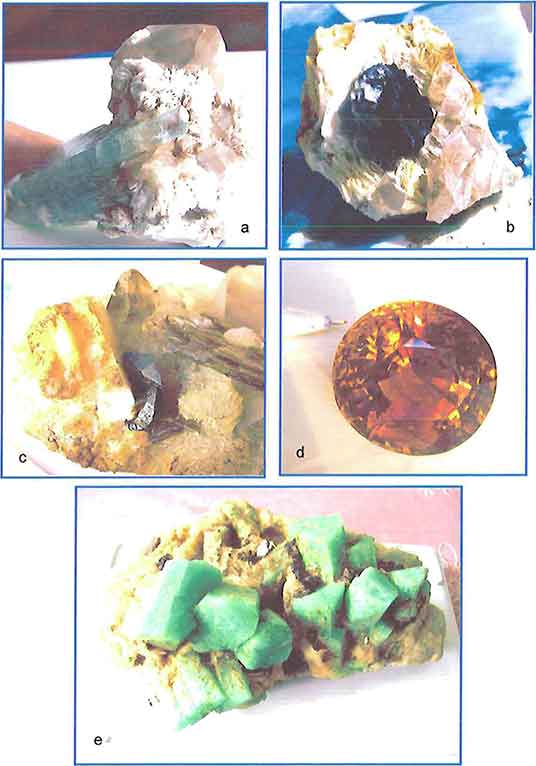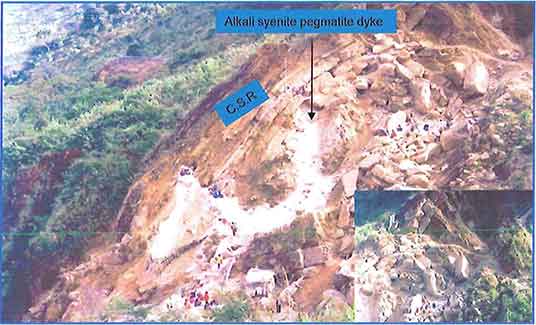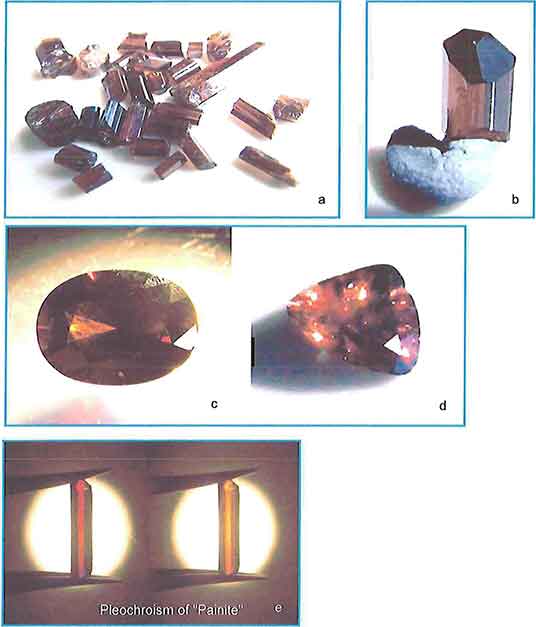![]()
Chapter VII – Economic Geology
and
Chapter VIII – Summary and Conclusions
A Ph.D. Dissertation by Kyaw Thu
Department of Geology, University of Yangon, Myanmar
Copyright © Kyaw Thu, 2007
Introduction from Bill Larson, Pala International
Kyaw Thu is a FGA gemologist with a Ph.D. in Geology. Pala International knows him from trips in the mid-1990s as one of the most interesting young gem enthusiasts, among so many wonderful students and collectors we met. Both Will and Bill Larson consider him a special and close friend. He has helped answer many questions regarding locality information for Brendan Laurs of GIA as well as meeting in person Dr. George Harlow of the American Museum of Natural History and corresponding with him for almost a decade. He has opened a gem laboratory and has applied to GIA to further his education. I was given a copy of his PhD thesis last month and Dr. Harlow made it available by scan for interested parties. Pala International is honored to share this with our readers.
Contents
See full table of contents here.
Chapter VII Economic Geology
-
Introduction
-
7.1 Classification of Mogok Gemstone Deposits
-
7.2 Gemstone Deposits in Phlegmatic
-
7.3 Gemstone Deposits in Yemenite
-
7.4 Peridot Deposits
-
7.5 Gemstones in Skarn
Chapter VIII Summary and Conclusions
-
8.1 Objectives and Scope of the Research
-
8.2 Geological Features
-
8.3 Spectrography
-
8.4 Microchemistry and Interpretations
-
8.5 Pathogenesis
-
8.6 Geochronology
-
8.7 Gemstones
List of Figures for Chapter VII (images from Pala International are not listed) |
|
| 7.1 | Location map of the pegmatitic gem deposit mines and other mines of Mogok Stone Tract |
| 7.2 | Highly weathered phlegmatic dyke exposure in Sakhan-gyi, 22° 54' 1.2" N, 96° 20' 56.1" E |
| 7.3 | Entrance of adit in phlegmatic mine, Sakhan-gyi, 22° 54' 1.2" N, 96° 20' 56.1" E |
| 7.4 | Illegal mines (Lay-bin-dwin) in phlegmatic deposit, since 2004, Sakhan-gyi, 22° 54' 02.1" N, 96° 20' 51" E |
| 7.5 | Searching the gems from phlegmatic, Sakhan-gyi, 22° 54' 02.1" N, 96° 20' 51" E |
| 7.6 | Lay-bin-dwin in phlegmatic mine, Sakhan-gyi, 22° 54' 02.1" N, 96° 20' 51" E |
| 7.7 | Phlegmatic with topaz,quartz, clevelandite, cassiterite and feldspar, Sakhan-gyi |
| 7.8 | Phlegmatic dyke at pan-taw area, entrance of adit in phlegmatic body and drilling in Kabaing Granite for blasting processes (in-set), 22" 57' 47.3" N, 96" 24' 15.6" E |
| 7.9 | (a) Large aquamarine crystal (21 ern in length), Sakhan-gyi; (b) rough aquamarine 134 g; (c) after faceted, 119 carats from Pein-pyit |
| 7.10 | (a) Topaz crystal in phlegmatic groundmass; (b) some big terminated topaz crystals; (c) topaz crystal penetrates in quartz with muscovite at the base; (d) unusual aquamarine cat’s eye, 90.80 carats, from Sakhan-gyi; (e) herderite crystal, 23.02 carats; (f) rough (120 g) and faceted (6.202 carats) yellow scheelites; (g) large elongated quartz crystal (10 cm in length); (h) large goshenite crystal, 8 x 6 x 4 cm, shows prism, pyramid and basal pinacoid |
| 7.11 | (a) Aquamarine, quartz and cleavelandite in phlegmatic matrix from Pan-taw; (b) phlegmatic with hematite and topaz; (c) phlegmatic with, cassiterite, c1eavelandite, muscovite and quartz from Pan-taw; (d) faceted sherry coloured topaz; (e) amazonite crystals in phlegmatic groundmass from Pan-taw phlegmatic deposits |
| 7.12 | (a) Ilmenorutile crystal and its X-RD spectrum; (b) rhodochrosite crystals and its X-RD spectrum; (c) colour-change fluorite from Pan-taw phlegmatic deposit |
| 7.13 | The miners digging the sapphire from alkali yemenite phlegmatic dyke in Buga mine, On-dan, 22° 59' 7" N, 96° 12' 51" E |
| 7.14 | Close-up view of sapphire bearing alkali yemenite phlegmatic dyke intruded into the phlogopite marble at Buga mine, On-dan |
| 7.15 | Sapphire-bearing alkali yemenite phlegmatic (highly weathered) dyke intruded to the leucogranite in Buga |
| 7.16 | Sapphire crystal associated with schorl in feldspar groundmass in alkali yemenite phlegmatic |
| 7.17 | Sapphire crystal with “black silk” in feldspar ground mass of nepheline yemenite, On-dan |
| 7.18 | (a) Large sapphire crystal; (b) sapphire package from UMEHL mine, On-dan |
| 7.19 | Panoramic view of Thurein Taung |
| 7.20 | Geological sketch model of Thurein Taung |
| 7.21 | Sapphire is enclosed by purplish spinel (X-RD result) from alkali yemenite phlegmatic, Thurein Taung |
| 7.22 | (a,b,c) Sapphires in alkali-feldspar groundmass of alkali-feldspar yemenite phlegmatic, Thurein Taung |
| 7.23 | Alkali yemenite phlegmatic dykes intruded in calc-silicate rocks and local miners digging sapphires from highly weathered alkali yemenite phlegmatic, JV mine of Lay-thar, 23° 00' 26.3" N, 96° 30' 19.5" E |
| 7.24 | Sapphires embedded in alkali feldspar groundmass of alkali yemenite phlegmatic, Lay-thar JV mine |
| 7.25 | Local miners searching the sapphires in Lay-thar JV mine, 23° 00' 26.0" N, 96° 30' 19.0" E |
| 7.26 | Fluid and silicate-melt inclusions of sapphires form alkali yemenite phlegmatic deposits, Mogok. (25 X, transmitted light and dark field) |
| 7.27 | Plotting diagram of Cr2O3/Ga2C (%wt) vs Fe2O3/TiO2(%wt) ratios shows the different populations and overlapping features of basaltic and non-basaltic blue sapphires (source: GAAJ) |
| 7.28 | Photograph showing the peridot mine and miners digging the dunite in entrance of the adit at Mya-sein Taung, 23° 00' 03.4" N, 96° 27' 54.4" E |
| 7.29 | Entrance of the tunnel and railway (made in local miners) used for carrying of peridotite-dunite wastages, Mya-sein Taung, 23° 00' 07.5" N, 96° 27' 51.0" E |
| 7.30 | Photograph showing the pocket nature of peridot deposit in dunite, although no gems in pocket locally called “Owe-poke” and filled only talc |
| 7.31 | Peridot crystal in dunite groundmass of fragment of pocket deposit from Zalat Taung |
| 7.32 | Aragonite with peridot from pocket deposit of dunite and its X-RD spectrum, Mya-sein Taung |
| 7.33 | Magnesiohornblende crystals, associate minerals of peridot, and its X-RD spectrum, Mya-sein Taung |
| 7.34 | (a, b) Gem quality peridot crystals from pocket type deposits, UMEHL mine, Mya-sein Taung; (c) rough peridot, 68 carats; (d) after faceted peridot 43 carats |
| 7.35 | Gem quality peridot lot from pocket type deposit, UMEHL mine, Mya-sein Taung and display in UMEHL Emporium |
| 7.36 | Marble and leucogranite contact indicate painite deposit at Wet-loo mine, 22° 54' 28.5" N, 96° 23' 34.9" E |
| 7.37 | Dealer purchasing painite from local miners, near Wet-loo mine |
| 7.38 | Dealer checking the painite by eye-side from local miners, near Wet-loo mine |
| 7.39 | Painite and rubies in leucogranite matrix, near Wet-loo mine |
| 7.40 | Huge painite aggregate with rubies from Thurein Taung |
| 7.41 | (a) Gem quality painite crystals; (b) painite shows prism, pyramid and pinacoid faces; (c) faceted painite (3.5 cts.) from Thurein Taung; (d) faceted painite from Namya, 0.59 cts.; (e) pleochroism effect of painite from Thurein Taung |
| 7.42 | Anatase crystal, shows blue colour, associated with painite from Thurein Taung |
| 7.43 | Baddeleyite crystal, associated with painite and its XRD spectrum from Thurein Taung |
| 7.44 | (a) Two-phase inclusion, transmitted light, 30 X; (b) rectangular shape liquid filled negative inclusions, transmitted light, 30 X ; (c) needle-like rutile inclusions, transmitted light, 30 X; (d) baddeleyite crystal inclusion in painite, transmitted light, 30 X ; (e) BSE image of srilankite inclusion in painite from Namya; (f) srilankite crystal inclusion in painite from Wet-loo, transmitted light, 30 X |
List of Tables |
|
| 7.1 | Genetic classification of gemstones from the Mogok Stone Tract |
| 7.2 | Various types of gemstones associated with igneous rocks |
| 7.3 | Classification of granitic pegmatites (modified after Cerny, 1991) |
| 7.4 | Classification of granitic pegmatites of the rare-element class (Cerny, 1991) |
| 7.5 | Classification of pegmatites of the rare-element class, beryl type for Sakhangyi and Pan-taw |
| 7.6 | Physical and optical properties of gemstones from Sakhan-gyi and Pan-taw pegmatites |
| 7.7 | Trace elements in sapphires from selected localities tested using LA- ICP-MS method |
Chapter VII Economic Geology
The geology of Mogok is quite complex, often confusing and full of surprises. Mogok gems are born in metamorphic, igneous and in skarn-contact zone rocks involving complex metasomatic, magmatic, pegmatitic and other processes. These gems are found in a variety of gem deposits, all concentrated in a relatively small area. In Mogok, one becomes convinced that all is possible. Mogok is truly a cornucopia of gems and minerals for avid collectors and connoisseurs alike. Mogok is sometimes said to be in a class of its own: “a prodigy of Nature!”
The momentous events that shaped the distinctive and probably unique geology of Mogok have produced extraordinary gems and minerals, most impressively preserved in the marbles, gneisses, syenites, etc. after ages of crystallization in Nature's laboratory. Each of these precious gifts has a different story to tell of genetic backgrounds, of long journeys covering millions of years prior to emergence in the world known to man.
Not surprisingly, many of the world’s finest and largest rubies, sapphires, spinels, peridots and other gems come from Mogok. Also found in Mong-long (south of Mogok) is the delicate reddish coloured rubellite, once valued by the Chinese as more precious than the ruby. One of the rarest gems on earth, painite, […] is found only in Mogok. In recent years additional exceedingly rare gemstones such as poudretteite, johachidolite, jeremejevite, serendebite, periclase, thorite, edenite, diaspore, herderite, etc. are found in Mogok. Undoubtedly, more rare and collector’s gems some of them may be new species are already in the gem market waiting for proper identification.
7.1 Classification of Mogok Gemstone Deposits
The gems at Mogok Stone Tract may be classified into three categories according to their mode of occurrences and genetic features as follows:
- Gemstones of metamorphic origin (example: ruby and spinel)
- Gemstones of igneous origin (example: pegmatitic gems, peridot)
- Gemstones in sukarno (example: painite)
 |
| Table 7.1. Genetic classification of gemstones from the Mogok Stone Tract. |
 |
| Table 7.2. Various types of gemstones associated with igneous rocks. |
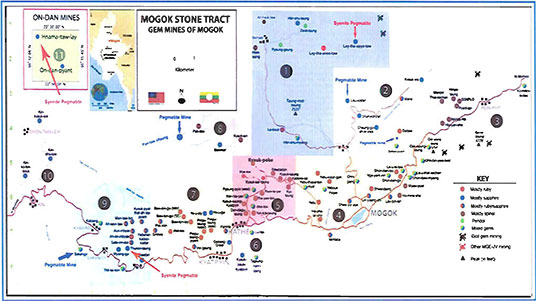 |
| Fig 7.1. Location map of the pegmatitic gem deposit mines and other mines of Mogok Stone Tract. (Click to enlarge.) |
Since this dissertation details mainly the igneous rocks of the Mogok-Kyat pyin, Bernard-pyaung-gaung and On-dan areas, gemstones of igneous origin will be mainly described. Recent study indicate that the pegmatitic gem deposits of Mogok can be classified into two categories based on their genetic features and associated minerals:
(a) Gemstone deposits in pegmatites
(b) Gemstone deposits in yemenite
7.2 Gemstone Deposits in Phlegmatic
These gemstones deposits are mainly recovered in the area at Sakhan-gyi, west of Mogok and Pan-taw, northwest of Mogok. Other small phlegmatic deposits are found at mid Dattaw, Lisu-kone-zan, Pein-pyit and Le-u areas.
The phlegmatic deposit at Sakhan-gyi (Fig. 7.1) is located about 16 km west of Mogok. For more than 100 years, Sakhan-gyi has been the main source of aquamarine, goshenite, topaz, quartz, danburite, and fluorite. Occasionally, gem quality zircon, scheelite, hassonite, herderite, cassiterite, columbite-tantalite, uraninite, thorite,lepidolite also are encountered. The phlegmatic dykes at least 30m wide are much kaolinized and crystals of orthoclase, c1eavelandite, microcline, quartz, muscovite, topaz, aquamarine, herderite, etc. are found in phlegmatic dykes that intruded the Kabaing Granite. The phlegmatic dykes at Sakhan-gyi is about 15 Ma, Middle Miocene (Searle and Ba Than Haq, 1964) old and the Kabaing Granite 15.8±1.1Ma, Middle Miocene (Bertrand et al., 2003).
The Pan-taw phlegmatic deposit is situated about 14.4 km northwest of Mogok and southern part of Kyauk-sin (Fig. 7.1). Since 2004, the area has lured local miners and gem traders as it produced gems such as; topaz (colourless, yellow. sherry colour). aquamarine, goshenite, quartz (amethyst, rock crystal, citrine. smoky), rhodochrosite, colour change fluorite. microcline, c1eavelandite, muscovite, cassiterite and etc. These phlegmatic dykes are also intruding the Kabaing Granite.
The nature of phlegmatic
The term phlegmatic was coined in the early 1800s by the French mineralogist Hauy to describe the geometric intergrowth of quartz and feldspar which is now known as graphic granite. Today, the term phlegmatic is applied as a textural description of the intruded igneous body. The phlegmatic can be recognized by its distinctive textures that consist of a very coarse-grained size, variable grained size that usually features an increase in grain size from the margin to its centre, and porphyritic layering.
Phlegmatic mineralogy is highly variable, ranging from the simple barren phlegmatic composed entirely of alkali feldspar, quartz, muscovite and biotite to the highly fractional mineralized rare-metal phlegmatic that may contain more than one hundred mineral species (Cerny, 1991).
Phlegmatic are the source of large sized impressive crystals. A vivid example of the massive size of some pegmatitic minerals is presented by a gigantic 19 feet long beryl crystal and 15 m long spodumene crystal that are associated with microclineperthite in a phlegmatic discovered at Keystone in the Black Hills of South Dakota, U.S.A (Hatch et al., 1956). Also, a massive quartz crystal found in a phlegmatic in Kazakhstan weighed about 70,000 kg, while another enormous crystal from Norway weighed 100,000 kg (Smirnov, 1976). Hundreds of smaller and beautiful crystals are found in numerous phlegmatic locations around the world. The pegmatites are also the main source for high-tech metals and minerals, such as rubidium, tantalum, tin,lithium and others (Cerny, 1991).
Classifications of pegmatitesNumerous classifications of the phlegmatic bodies have been proposed based on their form, size, relationship with the associated rocks, chemical composition, texture, internal structure, presumed origin, mode of development and other attributes. Moreover, some geologists have combined some of these features and proposed new classifications based on multiple criteria (Cerny, 1991).
1. Phlegmatic classification based on internal structure
According to Kerkvoort (1995), the pegmatites are classified into three types, based on their internal structures as follow:
a. Simple phlegmatic
This is the most common type of phlegmatic that consists only of quartz, feldspar and mica and has no internal structure. 99
b. Zoned phlegmatic
This type consists of quart, feldspar, mica and numerous accessory minerals. These minerals are formed in distinct zones (layers) with crystal size increasing toward the centre (or core) of the phlegmatic body. The zones are configured as concentric layers around a very coarse-grained core forming border, wall, intermediate and core zones. In these pegmatites, gemstones are found either in the core or in intermediate zones. forming core, intermediate and wall zones.
c. Complex phlegmatic
This phlegmatic is very similar to zoned phlegmatic, but it has undergone extensive alteration. Often numerous rare gems and minerals are found in irregular openings (pockets), which may vary greatly in size and have recorded diameters of up to several meters. These pockets may be found either in the core zone or between the edge of the core and intermediate zone.
2. Phlegmatic classification based on petrogenetic and other features
According to Cerny (1991), the pegmatites are classified into four classes, based on the metamorphic environments, depth of formation and petrogenetic criteria (Table 7.3). Cerny (1991) subdivided the rare element phlegmatic into five types of phlegmatic: rare-earth, beryl, complex, albite-spodumene and albite. This classification (Table 7.4) is often used by many researchers.
Following the model by Cerny (1991) and based on field observations, the author was able to classify the phlegmatic deposits at the Sakhan-gyi and Pan-taw areas shown in (Table 7.5).
3. Phlegmatic classification based on genetic features
Smirnov (1976) classified the phlegmatic deposits into the genetic classes of simple pegmatites, recrystallized pegmatites, metasomatic replacement pegmatites and desilicated pegmatites based on their mineral assemblages and intrusive bodies.
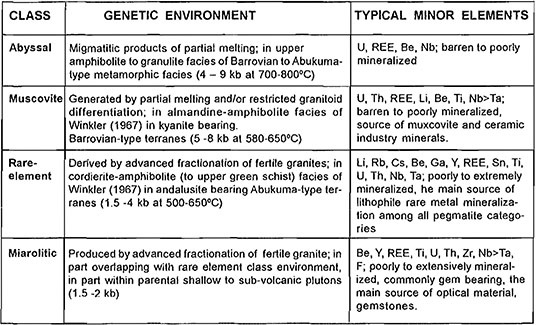 |
| Table 7.3. Classification of granitic pegmatites (modified after Cerny, 1991). |
Based on their intrusive nature and mineral assemblages, it is evident that the Sakhan-gyi and Pan-taw pegmatites are contemporary, but Molo phlegmatic are different type of rare-element class in granitic phlegmatic according to their mineral assemblages (Hla Kyi et al., 2005). Also, Sakhan-gyi phlegmatic is found intruding the Kabaing Granite which is 16 Ma, Middle Miocene (Searle and Ba Than Haq, 1964), 15.8±1.1 Ma, Middle Miocene (Bertrand et aI., 2003). Although, Molo phlegmatic is also found intruding the peridotite country rock (Hla Kyi et aI., 2005). The Kabaing Granite is also found intruding the ultramafic bodies of Mogok.
According to Cerny (1991), the pegmatites at Sakhan-gyi and Pan-taw areas were formed between 1.5 to 4 kb in depth at 500°–600°C. However, Khin Zaw (1998), studied the fluid inclusions of the quartz, topaz, and beryl from Sakhan-gyi phlegmatic in the area, indicate that the deposits equilibrated under a temperature range of 231°C to 410°C. Fluid inclusion homogenization data also indicate that Sakhan-gyi pegmatites have very narrow homogenization temperature ranges. These data place these pegmatites in the rare-element class, beryl type. According to the genetic classification proposed by Smirnov (1976) the phlegmatic of Sakhan-gyi and Pan-taw were formed by metasomatic alteration due to hot gaseous-aqueous mineralized solution which were chemically not in equilibrium with the primary phlegmatic forming mineral mass. Thus, these pegmatites are regarded as metasomatic replacement in origin.
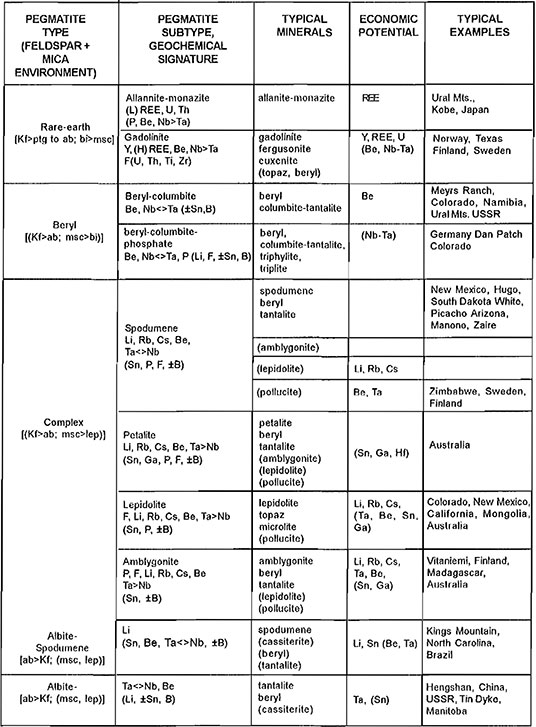 |
| Table 7.4. Classification of granitic pegmatites of the rare-element class (Cerny, 1991). Note: Minerals enclosed in parentheses indicate minor amounts. |
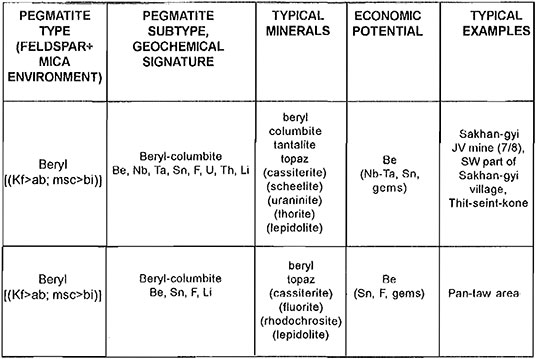 |
| Table 7.5. Classification of pegmatites of the rare-element class, beryl type for Sakhangyi and Pan-taw. |
The physical and optical properties of gem minerals from the Sakhan-gyi and Pan-taw pegmatites are given in Table 7.5. Cassiterite, scheelite, colour change fluorite, ilmenorutile, herderite, rhodochrosite are rare minerals found in Sakhan-gyi and Pantaw. Chemical analyses indicate that these minerals are rich in rare-earth elements and may be of significant economic importance.
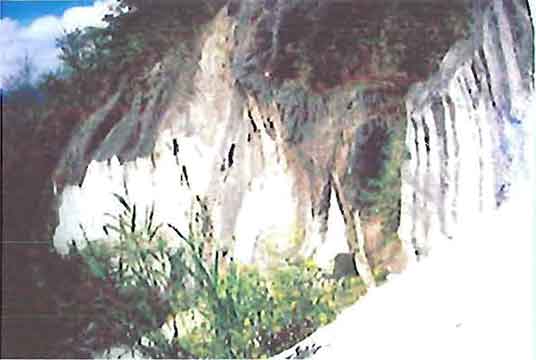 |
| Fig. 7.2. Highly weathered phlegmatic dyke exposure in Sakhan-gyi, 22° 54' 1.2" N, 96° 20' 56.1" E. |
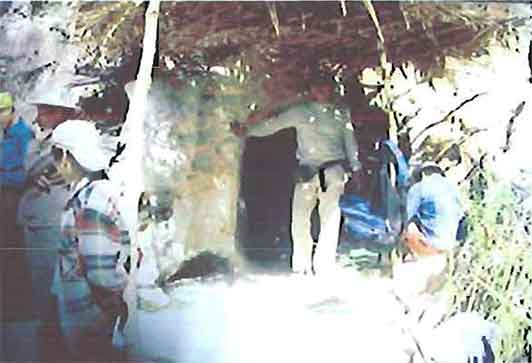 |
| Fig. 7.3. Entrance of adit in phlegmatic mine, Sakhan-gyi, 22° 54' 1.2" N, 96° 20' 56.1" E. |
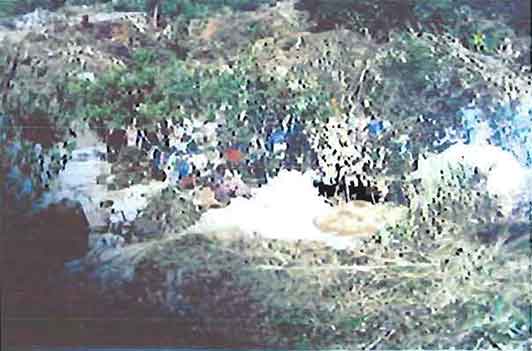 |
| Fig. 7.4. Illegal mines (Lay-bin-dwin) in phlegmatic deposit, since 2004, Sakhan-gyi, 22° 54' 02.1" N, 96° 20' 51" E. |
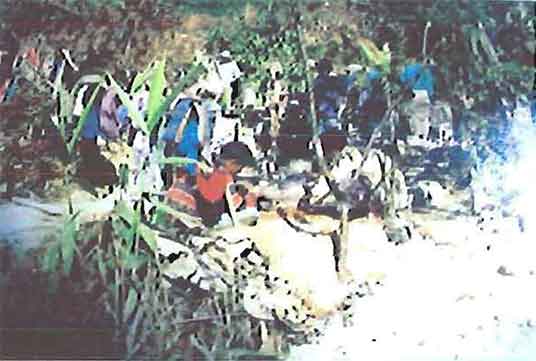 |
| Fig. 7.5. Highly weathered phlegmatic dyke exposure in Sakhan-gyi, 22° 54' 1.2" N, 96° 20' 56.1" E. |
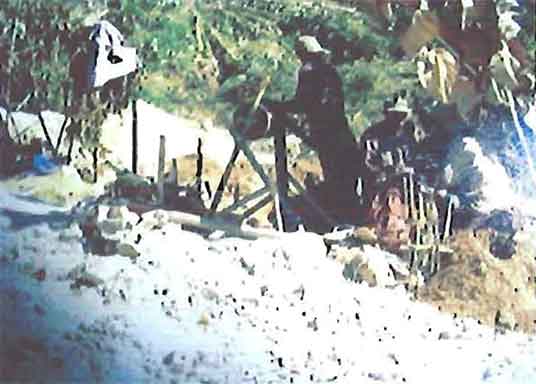 |
| Fig. 7.6. Lay-bin-dwin in phlegmatic mine, Sakhan-gyi, 22° 54' 02.1" N, 96° 20' 51" E. |
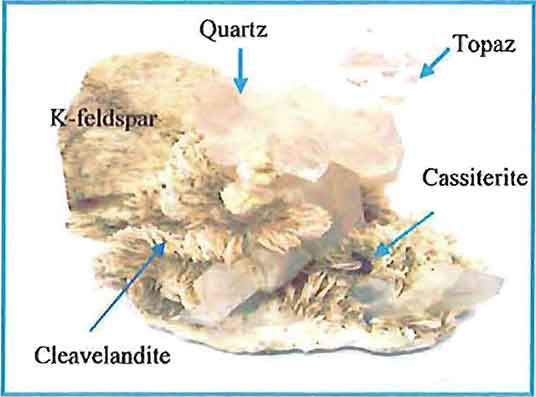 |
| Fig. 7.7. Phlegmatic with topaz,quartz, clevelandite, cassiterite and feldspar, Sakhan-gyi. |
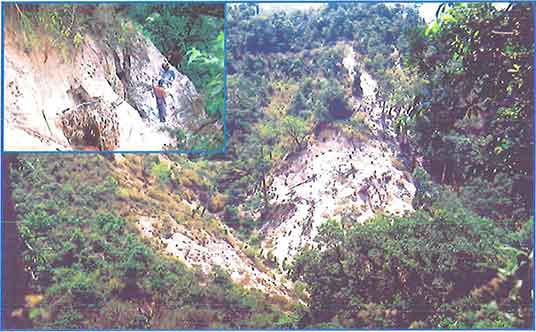 |
| Fig. 7.8. Phlegmatic dyke at pan-taw area, entrance of adit in phlegmatic body and drilling in Kabaing Granite for blasting processes (in-set), 22" 57' 47.3" N, 96" 24' 15.6" E. |
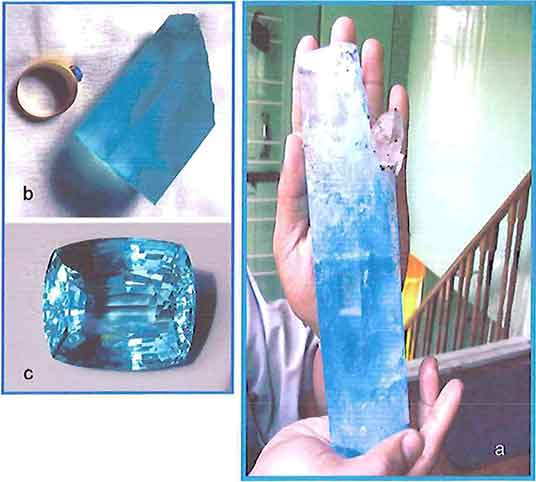 |
| Fig. 7.9. (a) Large aquamarine crystal (21 ern in length), Sakhan-gyi; (b) rough aquamarine 134 g; (c) after faceted, 119 carats from Pein-pyit. |
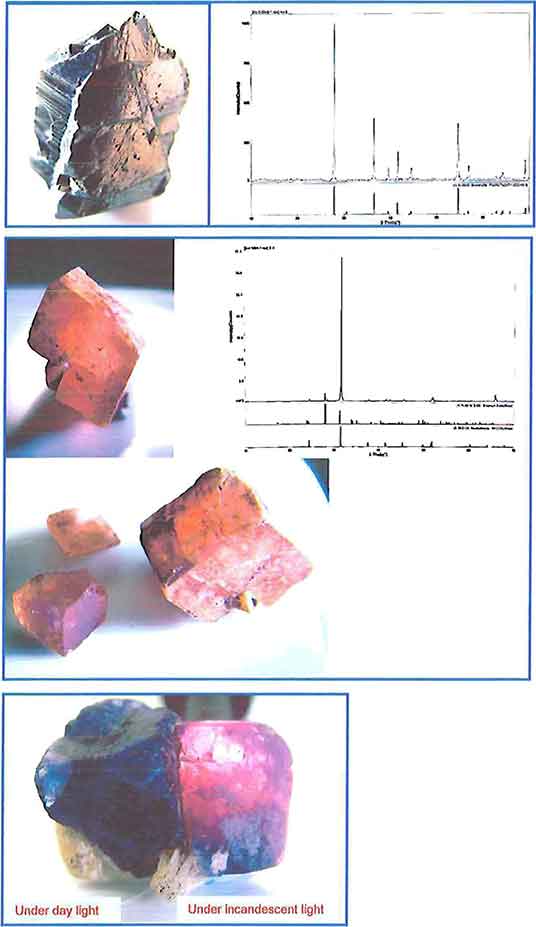 |
| Fig. 7.12. (a) Ilmenorutile crystal and its X-RD spectrum; (b) rhodochrosite crystals and its X-RD spectrum; (c) colour-change fluorite from Pan-taw phlegmatic deposit. |
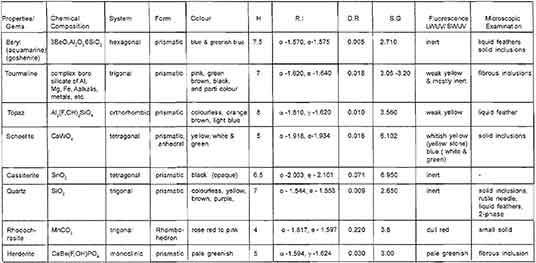 |
| Table 7.6. Physical and optical properties of gemstones from Sakhan-gyi and Pan-taw pegmatites. (Click to enlarge.) |
7.3 Gemstone Deposits in Yemenite
The genesis and origin of the sapphires found in Mogok is very complicated and it is not fully understood. It is generally postulated by many geologists that the sapphires at Mogok derived from the syenitic parental magma and subsequent desilicification of granitic melts (granite) by reaction with the intruded marbles. The process is often enhanced by post-magmatic metasomatic fluids, as evidenced from liquid-gaseous inclusions found in the sapphires.
Aluminous enriched parental magma rose as intrusions and sapphire crystals were formed as segregations within the nepheline yemenite and urtite, and than a later stage hydrothermally as veins in alkali yemenite pegmatites. Aluminium rich yemenite rocks (see Table 4.1) containing the proper ratio of chromophoric impurities of iron and titanium may produce blue sapphire under favourable conditions during the growth process. Yellow, orangy yellow, orangy, purple and other coloured sapphires are also found in Mogok, their colour is due mainly to iron association with other chromophoric impurities and to structural defects residing in their crystal lattice.
Sapphires do not occur in marble. Under certain circumstances sapphires may be found in, or around, the contact zone between a weathered alkali-feldspar yemenite phlegmatic or urtite bodies and marble and in the skarns. Based on genetic characteristics of the sapphires at Mogok may be classified into two types, represented in two models:
Model A: Nepheline yemenite
Model B : Alkali-feldspar yemenite phlegmatic
As in Mogok, the alkali-feldspar yemenite phlegmatic deposits are mainly discovered at:
- On-dan (Hnama-taw-Iay range)
- Thurein Taung (west of Kyat-pyin)
- Lay-tha-apya-taw (NE of Bernard-myo)
a. On-dan (Hnama-taw-Iay range)
It is situated about 57.6 km northwest of Mogok and this area is highly rugged and mountainous. In this area sapphire bearing alkali yemenite phlegmatic dykes were found intruding into the leucogranite and marble (diopside marble and white marble) at Buga mine (MGE-JV mine) and UMEHL mines. Upper part of phlegmatic dykes is about five feet in thickness and is mainly composed of highly weathered feldspar (altered to clay-like material) with sapphire. These sapphires are associated with schorl, biotite and garnet (dominantly purplish red almandite). Notably sapphire from these mines are gigantic sizes, ranging in size from 25–30 cm in length. An important and characteristic feature of On-dan sapphire is the silk. The silk present in the sapphires, which originated from the alkali yemenite pegmatites, is “white” and may be removed by heat treatment. The silk present in the sapphires, which originated from nepheline yemenite, is “black” and cannot be removed by heat treatment, it always appears “dead-black.”
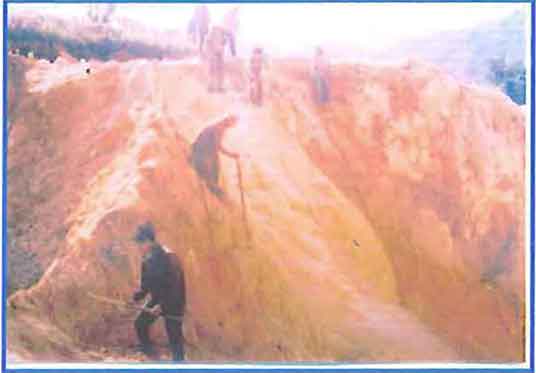 |
| Fig. 7.13. The miners digging the sapphire from alkali yemenite phlegmatic dyke in Buga mine, On-dan, 22° 59' 7" N, 96° 12' 51" E. |
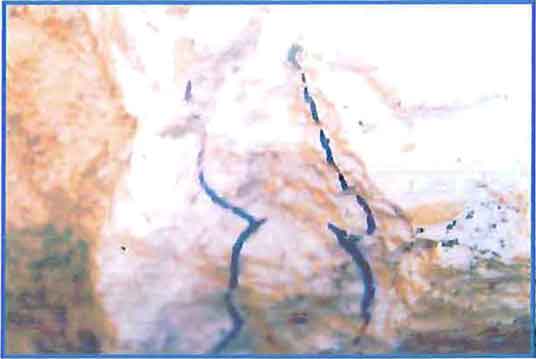 |
| Fig. 7.14. Close-up view of sapphire bearing alkali yemenite phlegmatic dyke intruded into the phlogopite marble at Buga mine, On-dan. |
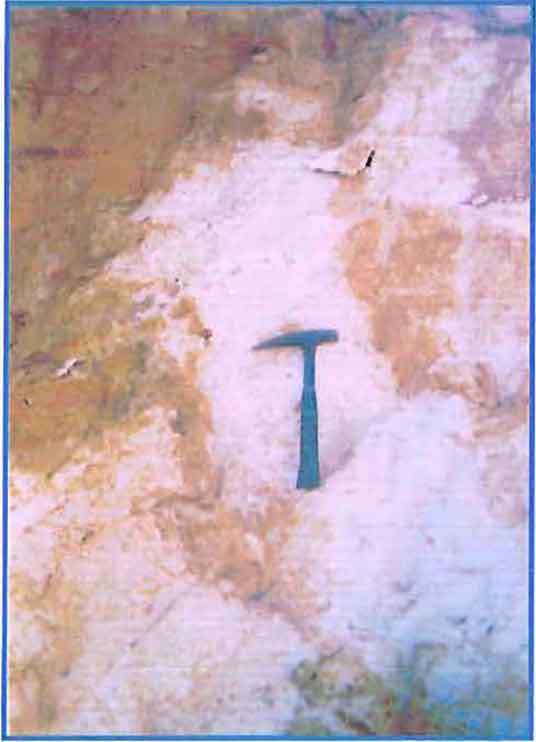 |
| Fig. 7.15. Sapphire-bearing alkali yemenite phlegmatic (highly weathered) dyke intruded to the leucogranite in Buga. |
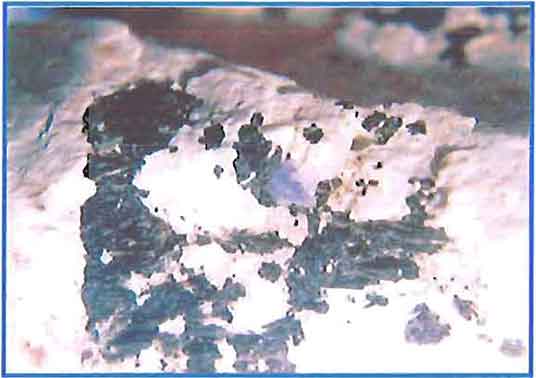 |
| Fig. 7.16. Sapphire crystal associated with schorl in feldspar groundmass in alkali yemenite phlegmatic |
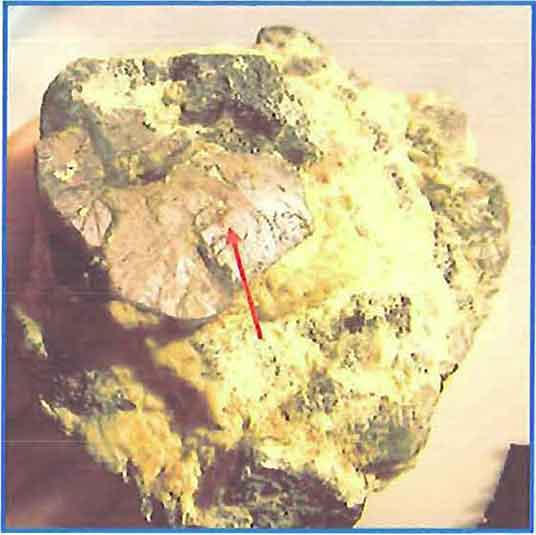 |
| Fig. 7.17. Sapphire crystal with “black silk” in feldspar ground mass of nepheline yemenite, On-dan. |
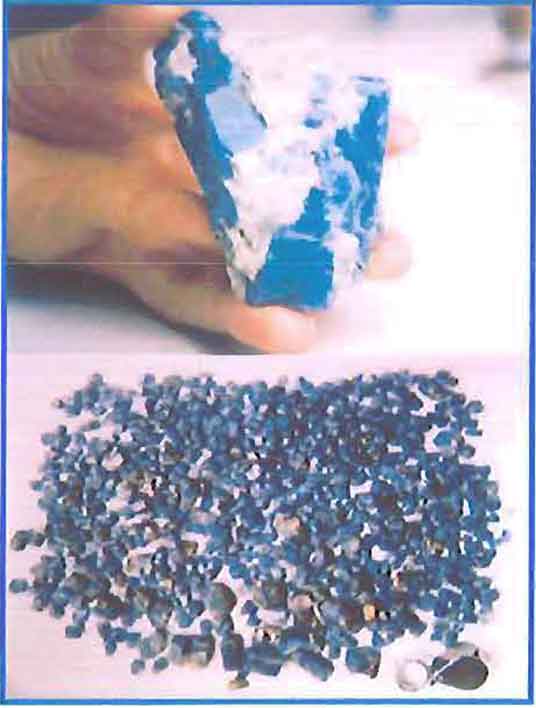 |
| Fig. 7.18. (a) Large sapphire crystal; (b) sapphire package from UMEHL mine, On-dan. |
Extensive geological studies suggest the sapphires at On-dan are of magmatic origin enriched by post contact metamorphism. These types of sapphires crystallized from salic melts about 25 to 40 km deep in the Earth (upper part of the lower crust) at 600°C–900°C temperature (Sutherland et al., 1998).
In some area in On-dan, nepheline yemenite and alkali yemenite phlegmatic are intruded into marble, producing scapolite-diopside skarns caused by contact metamorphism. In On-dan, the sapphires occur either segregated in nepheline yemenite or disseminated in highly weathered (almost altered to clay) dykes in alkali yemenite phlegmatic It is postulated that these primary syenitic rocks are affected by the desilicification process, influenced by volatiles. Around these igneous bodies there are mixed, desilicified and metasomatized hybrid zones, which also bear sapphires.
b. Thurein Taung
It is situated at west of Kyauk-pyat-that village, 11 km west of Mogok. The alkali yemenite phlegmatic and alkali rich igneous rocks (mainly ijolite and nepheline yemenite) intruded into the marble and gneiss. Recent study suggest that the sapphire of the Thurein Taung area and the adjacent area at Kyauk-pyat-that are due to the magmatic intrusion. The morphology of the present-day, Kyauk-pyat-that general area suggests that the eastern side of the Thurein Taung hill was at one time connected to the western part of the hill by the name of Kathe-yaike and was later separated by a major fault, forming a narrow corridor, which now runs northward, up to the village of Sin-khwa.
Geological uplift of the area from great depths, involving high pressure and high temperature, created the Thurein Taung hill rocks, where sapphires and other gems originated and were later weathered to form secondary deposits. The uplift penetrated portion of the non-weathered primary deposit and created a long, nearly vertical dyke composed of alkali rich igneous rocks (alkali yemenite phlegmatic) running through the Thurein Taung. The southeastern part of the Thurein Taung is composed of country rock with non-gem bearing marble, while the northeast part is composed mostly of country rock of gem bearing marble. In the partly karst topography, numerous caves, deep fissures and narrow crevices were formed, some of them very large, where rubies, sapphires and other gems are recovered.
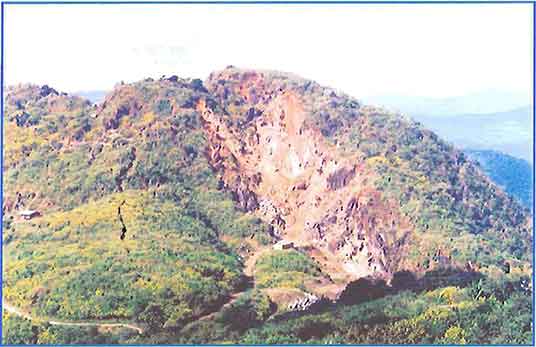 |
| Fig. 7.19. Panoramic view of Thurein Taung. |
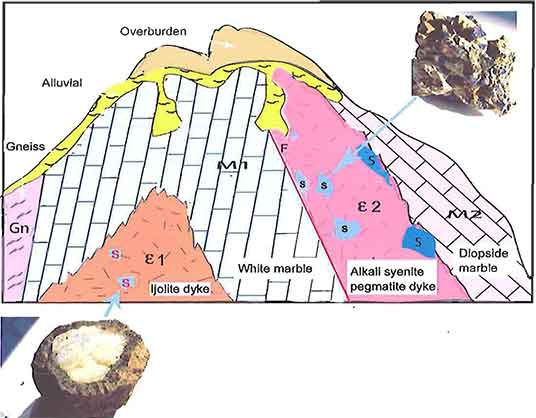 |
| Fig. 7.20. Geological sketch model of Thurein Taung. |
Evidence of the Thurein Taung dyke showed up on thin petrographic sections of core samples taken in the late 1960s by the Burma Geological Department. The sapphire are found embedded in the dyke in pockets as single or multiple nodule-like aggregates, fully encased in a rim of weathered white clay-like material. These pockets were classified as follows:
- Type-A: pocket consisting of a single sapphire crystal encased in a white clay-like rim.
- Type-B: pocket consists of multiple sapphire crystals all encased in a white clay-like material.
In this area, thickness of alkali yemenite phlegmatic dykes ranges from one to three meters and it is highly weathered. Since 1970s and 1980s, extensive mining was performed in the dykes (after local miners). The sapphires were mined by digging small tunnels in irregular patterns. Miners followed the white clay-like material until the sapphire pockets are recovered. Blue sapphires are found in all qualities and size in these aggregate pockets, which measure about 25 to 30 cm in diameter on average and are embedded randomly in the dyke. Sapphires are associated with spinel, biotite and schorl, and measure about 1–10 cm in diameter on average.
At this time, most of the pockets have been mined out, due to intense mining in the area, so most of the sapphires are found in the alluvial. Yet, Thurein Taung still produces significant amounts of blue sapphires, often in large and fine quality crystals.
(c) Lay-thar-apya-taw
This mine is located at NE of Bernard-myo near Mogok-Momeik border, at 23° 00' 23.5" N and 96° 29' 18.3" E, about 1485 m above sea level. The alkali yemenite phlegmatic intruded into the calc-silicate rocks and this area is composed of white marble, calcsilicate rocks, garnet-biotite gneiss and yemenite These phlegmatic dykes are found trending nearly NE-SW. Sapphires are associated with biotite, garnet, spinel and schorl, transparent to translucent, about 0.5 to 10 cm in diameter on average size.
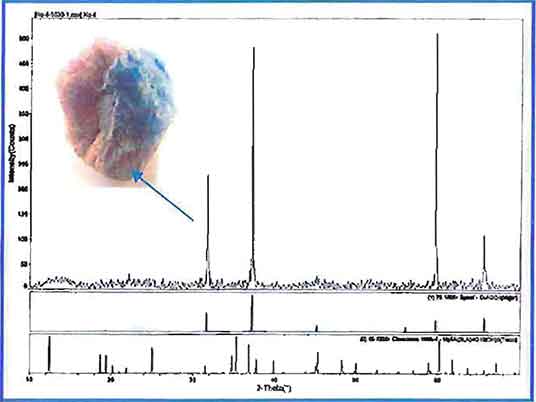 |
| Fig. 7.21. Sapphire is enclosed by purplish spinel (X-RD result) from alkali yemenite phlegmatic, Thurein Taung. |
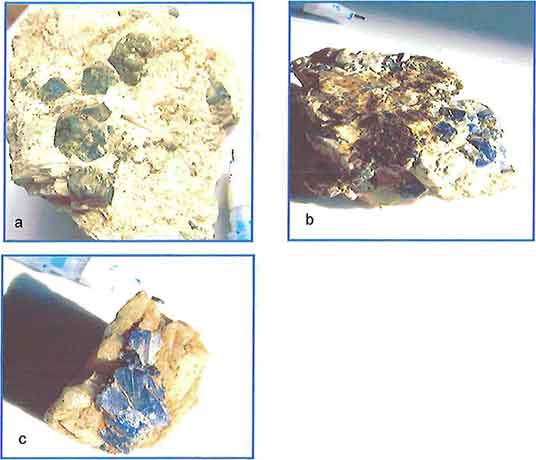 |
| Fig. 7.22. (a,b,c) Sapphires in alkali-feldspar groundmass of alkali-feldspar yemenite phlegmatic, Thurein Taung. |
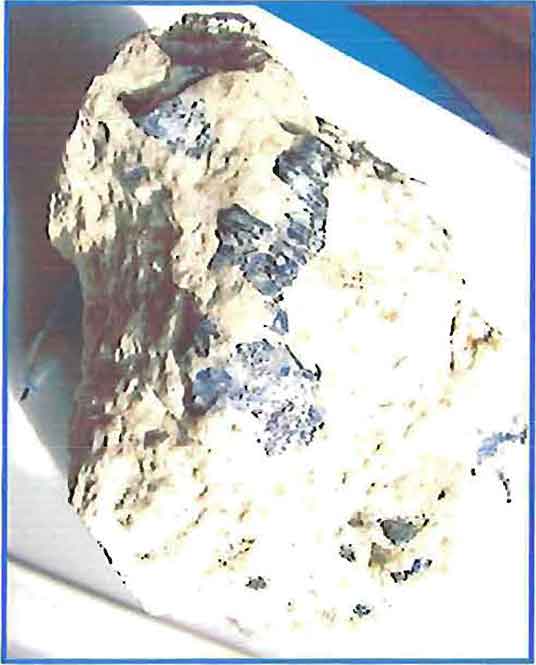 |
| Fig. 7.24. Sapphires embedded in alkali feldspar groundmass of alkali yemenite phlegmatic, Lay-thar JV mine. |
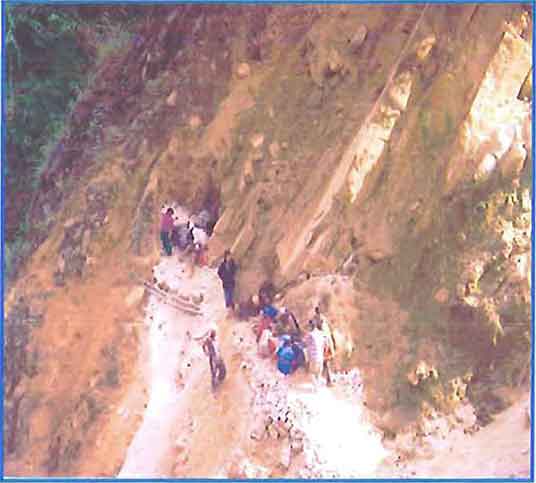 |
| Fig. 7.25. Local miners searching the sapphires in Lay-thar JV mine, 23° 00' 26.0" N, 96° 30' 19.0" E. |
Characteristics of Sapphires of the Area
Most of the sapphires at On-dan, Thurein Taung and Lay-thar are embedded in white albite matrix. Noted for gigantic size, often 25 to 30 cm in length, non-gem quality, opaque sapphire crystals are found at the alkali-feldspar yemenite phlegmatic deposits, On-dan. Sometimes crystalline sapphires of gem quality are found in these phlegmatic deposits at Hnama-taw-Iay range.
The minor and trace element concentrations in the blue sapphires from Mogok area using LA ICP-MS method indicated that they are enriched in Fe2O3, TiO2, Cr2O3 and Ga2O3. The Cr2O3/Ga2O3 ratio is low, while the Fe2O3/Cr2O3 ratio is high, conforming with other “magmatic-type” corundum from other corundum bearing deposits (Sutherland et al., 1998). By comparison, the “metamorphic-type” corundums have low Ga2O3 (>0.01%) and a high Cr2O3/Ga2O3 ratio.
According to LA ICP-MS method, sapphires of alkali yemenite phlegmatic of Mogok indicate that distinction between “basaltic type” (Thailand, Australia, China) and “non-basaltic type” (Mogok, Sri Lanka, Ilakaka) is easily accomplished by chemical fingerprinting.
Inclusions study using by standard gemmolite and laser raman spectroscopy (LRS) indicate that various solid I fluid inclusions (see Fig. 7.26 and Appendix) in these sapphires. So, these facts suggest that the sapphires of the area are evidence of magmatic-pegmatic involvement in the formation of sapphires. Often due to overlapping features of chemical fingerprinting, the distinction within each of these two types may be difficult. Thus, Sri Lankan blue sapphires may be confused from those from Mogok; moreover, Madagascan blue sapphires may be mistaken as Sri Lankan. There are many instances where the origin of blue sapphires cannot be determined. However, the presence of minor trace elements such as Zn, Sn, Ba, and Pb (in the order of ppm) in Mogok blue sapphire is regarded of paramount importance in distinguishing Mogok blue sapphires from those emanated from other localities. Therefore, the determination of the origin is difficult, unless characteristic absorption spectra in combination with inclusion characteristics and other gemmological features are obtained.
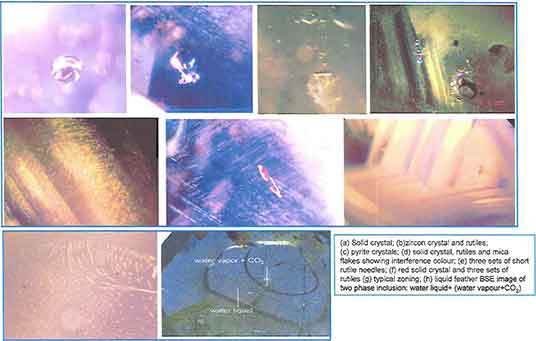 |
| Fig. 7.26. Fluid and silicate-melt inclusions of sapphires form alkali yemenite phlegmatic deposits, Mogok. (25 X, transmitted light and dark field) (Click to enlarge) |
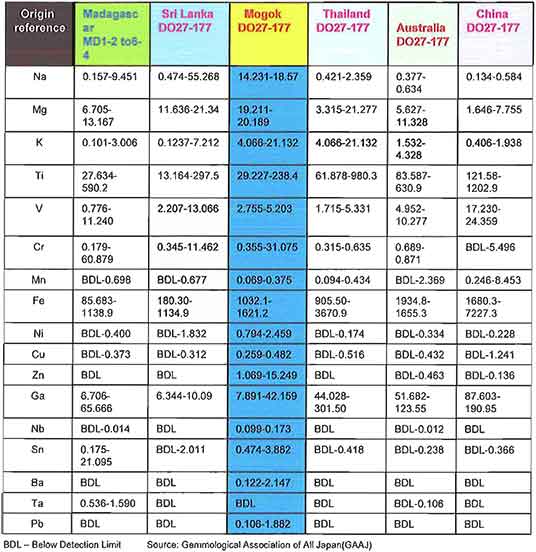 |
| Table 7.7. Trace elements in sapphires from selected localities tested using LA- ICP-MS method. |
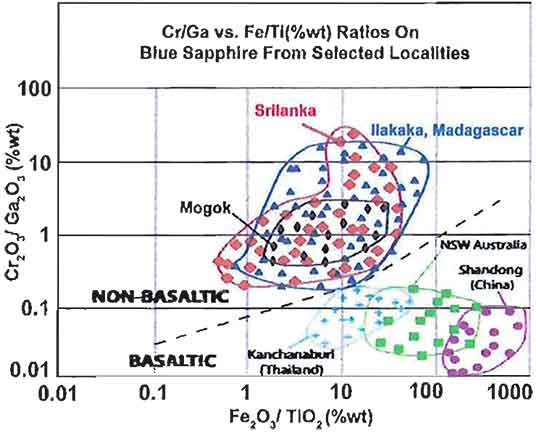 |
| Fig. 7.27. Plotting diagram of Cr2O3/Ga2C (%wt) vs Fe2O3/TiO2(%wt) ratios shows the different populations and overlapping features of basaltic and non-basaltic blue sapphires (source: GAAJ). |
7.4 Peridot Deposits
There are several proposed theories on the genesis of peridot at Bernard-Pyaung-gaung area. Today, most geologists accept that peridot derived from intrusions of igneous rocks belonging to the ultramafic rocks. Peridot occurs in:
- pockets in dunite-peridotite
- porphyritic crystals (phenocrysts) in dunite-peridotite
a. Pockets in dunite-peridotite
The process described below refers to the formation of dunite by accumulation of olivine crystals in the magma chambers, a process known as cumulative igneous crystallization. Magma rich in magnesium, iron and silicon intruded into the country rock producing peridotites containing olivine.
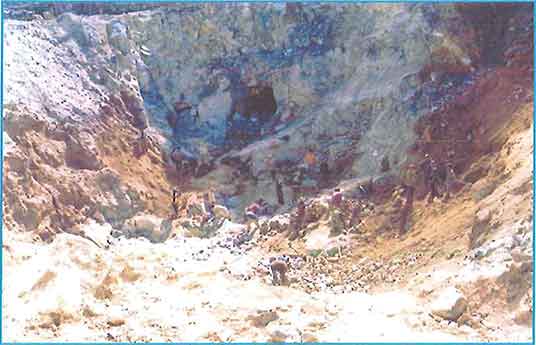 |
| Fig. 7.28. Photograph showing the peridot mine and miners digging the dunite in entrance of the adit at Mya-sein Taung, 23° 00' 03.4" N, 96° 27' 54.4" E. |
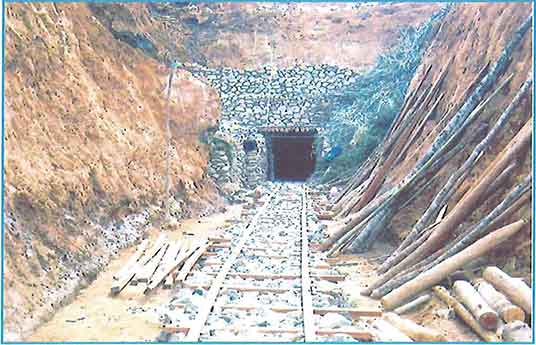 |
| Fig. 7.29. Entrance of the tunnel and railway (made in local miners) used for carrying of peridotite-dunite wastages, Mya-sein Taung, 23° 00' 07.5" N, 96° 27' 51.0" E. |
Depending on the crystallization conditions, peridots may be formed as single individual euhedral to subhedral crystals with pinacoid, prism and pyramid faces, as well as in multiple clusters pointing towards the center of the pocket. The shape and size of the pockets depend upon the nature and amount of residual trapped Mg-Fe rich liquid. The shape of the pocket may be round, oval or distorted lenticular; the size may range from a few centimeters to over a meter in diameter. Often, talc, enstatite, actinolite, magnesiohornblende, aragonite and Mg- mica surround these pockets.
The best quality peridot crystals are found on top of the dunite-peridotite body, called the cupola. Local Chinese miners called the best single peridot crystals “king,” the second-best “queen,” and all others “royal children.”
b. Phenocrysts in dunite-peridotite
Phenocrysts of peridot in dunite form in two different crystallization stages. In the first stage, the initial magma chemical composition at higher temperature, and pressure in the magma chamber, crystallized subhedral to anhedral magnesium rich peridot crystals. In the second stage, when the temperature in the magma was reduced, fine-grained dunite formed, engulfing the larger crystallized peridot crystals as phenocrysts, like a porphyritic texture. This could take place at different depths, if the geological uplift of the magma carried the phenocrysts to upper levels of the Earth’s crust, before rapid cooling consolidated the dunite matrix.
Description of peridot
The colour of the peridot may be olive-green, yellow-green, greenish and similar colours. Peridot occurs in transparent, translucent and opaque crystals often exceeding 5cm in length. Cut stones over 300 carats have been cut. Gem quality four-ray star peridots are also known, due to the two sets of small needle like inclusions and chatoyancy peridots are also found in these mines.
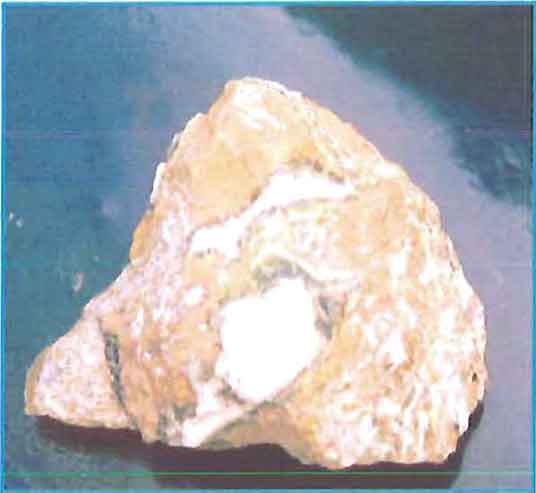 |
| Fig. 7.30. Photograph showing the pocket nature of peridot deposit in dunite, although no gems in pocket locally called “Owe-poke” and filled only talc. |
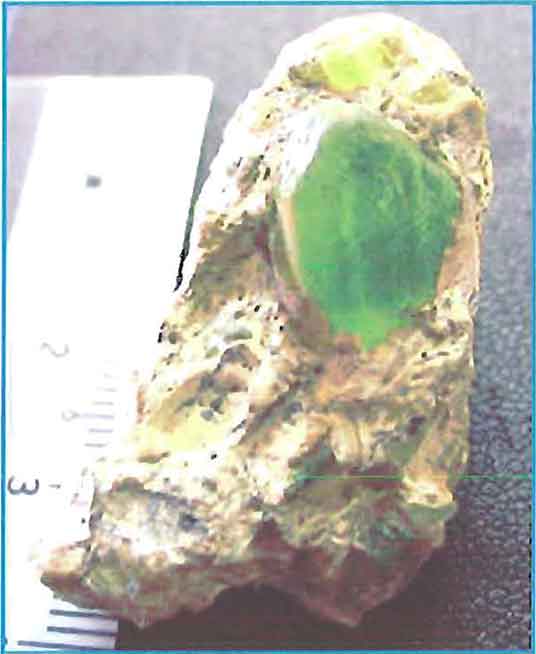 |
| Fig. 7.31. Peridot crystal in dunite groundmass of fragment of pocket deposit from Zalat Taung. |
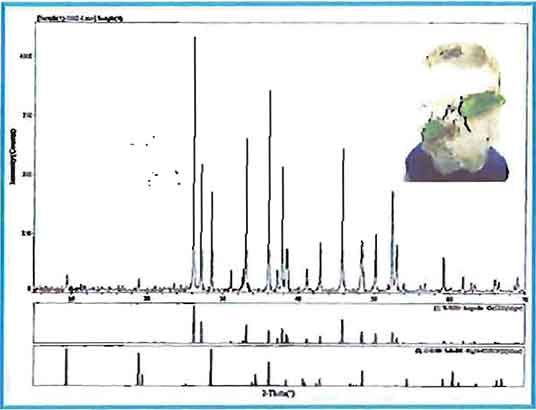 |
| Fig. 7.32. Aragonite with peridot from pocket deposit of dunite and its X-RD spectrum, Mya-sein Taung. |
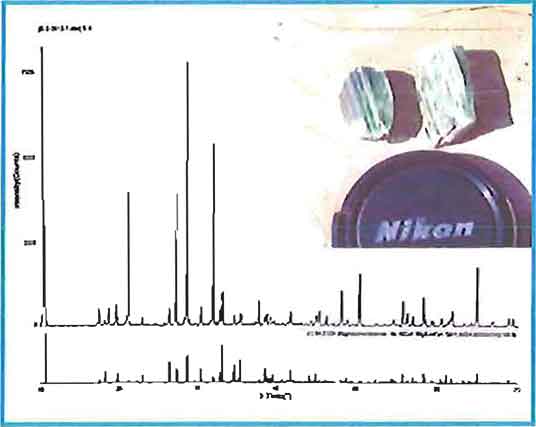 |
| Fig. 7.33. Magnesiohornblende crystals, associate minerals of peridot, and its X-RD spectrum, Mya-sein Taung. |
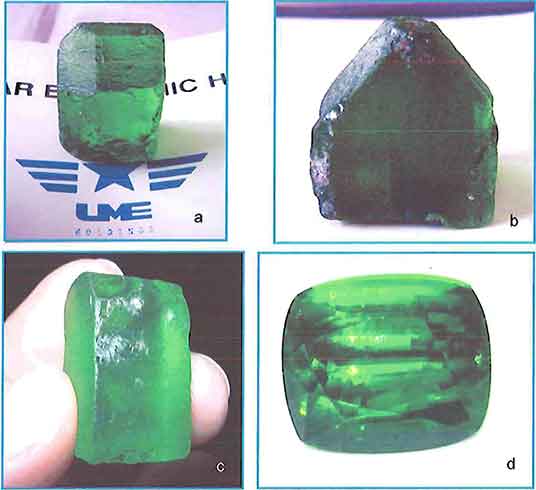 |
| Fig. 7.34. (a, b) Gem quality peridot crystals from pocket type deposits, UMEHL mine, Mya-sein Taung; (c) rough peridot, 68 carats; (d) after faceted peridot 43 carats. |
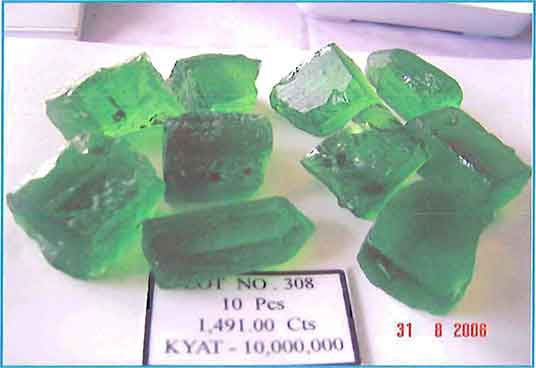 |
| Fig. 7.35. Gem quality peridot lot from pocket type deposit, UMEHL mine, Mya-sein Taung and display in UMEHL Emporium. |
Associated minerals
Peridot is associated with yellowish brown phlogopite, antigorite, talc, actinolite, chromite, brownish to greenish enstatite, chrysoprase, magnesio-hornblende, and aragonite.
Location
Currently, both types of peridot are found in the primary deposits at Mya-sein Taung, Zalat Taung and Htin-shu Taung, with UMEHL and MGE-JV mines and are still working yet. Peridots are also found in the alluvial deposits in the adjacent areas (Panlin, Pyaung-gaung village, etc.).
7.5 Gemstones in Skarn
In Mogok area, some collector's gemstones were recovered from skarn or contact zone, such as syenite and marble contact (example: ruby), leucogranite and marble contact (example: painite and ruby) , and also leucogranite and gneiss contact (example: sinhalite, serendebite) and others.
Painite Deposit
Painite, CaZrBAl9O18, was a rare mineral previously as only two crystals were first found by A.C.D. Pain in 1950 from the vicinity of Ongaing village in the Mogok Stone Tract (Rossman et al., 2005). Since mid 2005, new painite deposits were found in Wet-loo and Thurein Taung as primary deposits, and also in Baw-Ione-gyi and Ye-aye as secondary deposits. Also, it has now been found as slightly water-worn crystals among alluvial spinel, corundum and zircon from Namya (Nan-ya-seik), Kachin State, some 300 km to the northwest of Mogok. The new painite crystals from Namya, 50 km northwest of Mogaung, are pale pink and dichroic from pale orangish-pink to nearly colourless. (Rossman et al., 2005).
Painite from Namya is fluorescent under UV light. Also CL (cathodo luminescence) shows both planar and irregular growth zoning on a scale of <10 mm banding.
Primary deposits of painites from Wet-loo JV mine and Thurein Taung area mines suggests growth during skarn forming evenly between leucogranite and phlogopite marble, associated with ruby. In this area, leucogranite intrusives are faulted contact with phlogopite marble along the Wet-loo stream and Thurein Taung. The painite bearing contact zone is localized, about 3 to 6 m in width and up to 10m in length. Minerals associated with painite include ruby, scapolite, spinel, phlogopite, tourmaline, pyrite and margarite from Wet-loo mine and also ruby, scapolite, mica, pargasite, tourmaline, baddeleyite, anatase, sphene, pyrite and etc. from Thurein Taung area mines. The silicates are typical of skarns and argue for interaction between magmas (or their fluids) and marble. A conspicuous textural feature of these mineral assemblages is ruby crystallized on painite, demonstrating ruby growth during skarn formation.
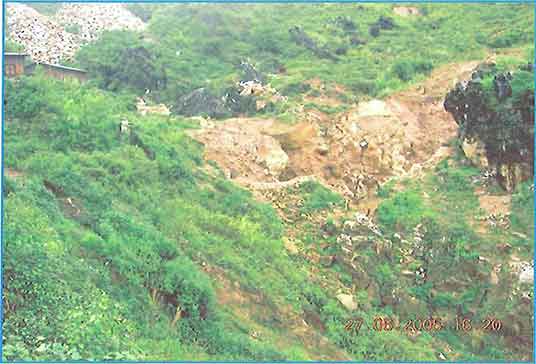 |
| Fig. 7.36. Marble and leucogranite contact indicate painite deposit at Wet-loo mine, 22° 54' 28.5" N, 96° 23' 34.9" E. |
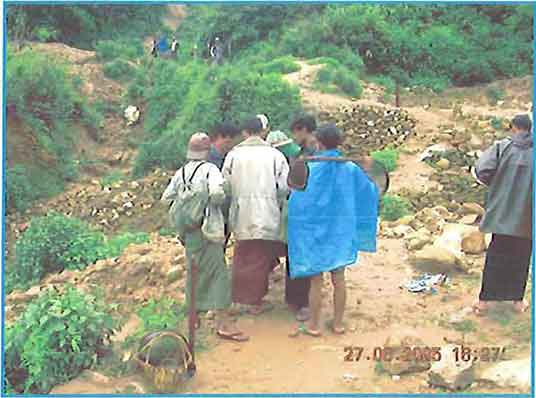 |
| Fig. 7.37. Dealer purchasing painite from local miners, near Wet-loo mine. |
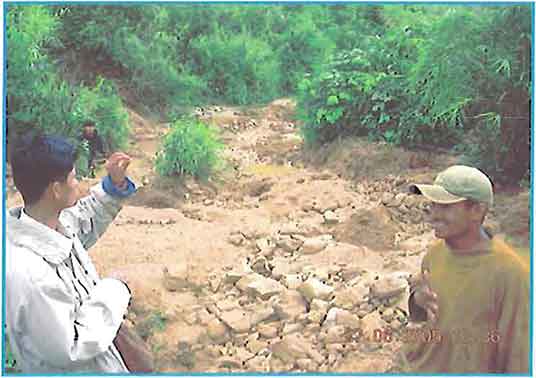 |
| Fig. 7.38. Dealer checking the painite by eye-side from local miners, near Wet-loo mine. |
The fact that rubies are surrounded or connected to skarn-silicate veins may indicate ruby crystallization is affected or even produced by the skarn reactions. Minor elements observed in EMP and X-RF analyses of all painites include Ti, V, Cr, Fe and Hf. Thus, Cr and V control the red to brown coloration in all samples and produce optical absorption bands at 398, 455 and 550 nm. The Namya painite analyzed to date contains nearly an order of magnitude lower concentration of these elements and is proportionally less intensely coloured (Rossman et al., 2005).
Inclusions within painite include liquid CO2, rutile needle, srilankite (Ti,Zr)O2, baddeleyite (ZrO2), a CaAl-silicate, and calcite. Painite from both Mogok and Namya localities share a distinctive Raman spectrum. [According to a] recent U/Pb radiometric dating study, the zircon inclusion in painite sample (P-1) was from the contact zone of leucogranite and marble, associated with ruby in leucogranite matrix in Wet-loo, 22" 54' 28.5" N, 96" 23' 34.9" E. The core zone of zircon gave Late Cretaceous (83±4 Ma), and the other zone shows Eocene (44±4 Ma) to as young as Miocene (16.1±0.5 Ma). So it can be postulated that the formation of ruby with painite in contact metamorphism was associated with these ages (Miocene; 16.1 ±0.5 Ma). Wet-loo and Thurein Taung deposits, known for painite and ruby, are sourced from the contact of the marbles of Mogok Metamorphic Belt (MMB) and early Oligocene leucogranite intrusion that have experienced various metamorphic events, formed due to metasomatism at Oligocene to Miocene in age. [According to] field evidence and above factors, the origin of painite and associated ruby is Fe2+ depleted by metasomatism or to Si depletion metasomatism followed by Ca reaction metasomatism. Painite is consistent with these models that yield refractory oxides and calc-silicate overgrowths.
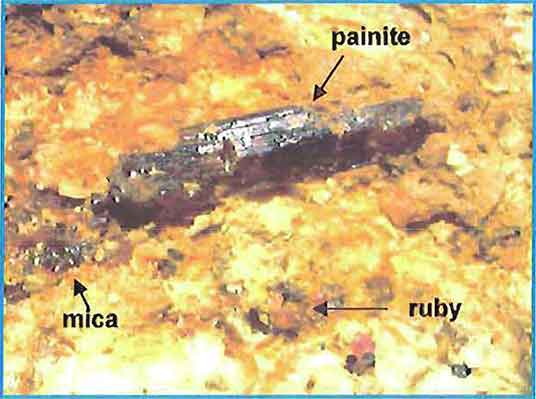 |
| Fig. 7.39. Painite and rubies in leucogranite matrix, near Wet-loo mine. |
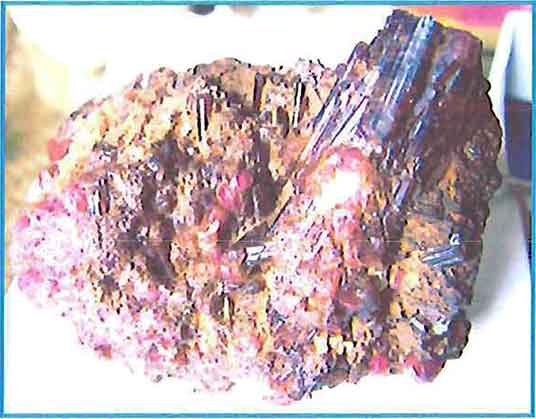 |
| Fig. 7.40. Huge painite aggregate with rubies from Thurein Taung. |
 |
| Fig. 7.42. Anatase crystal, showing blue colour, associated with painite from Thurein Taung. |
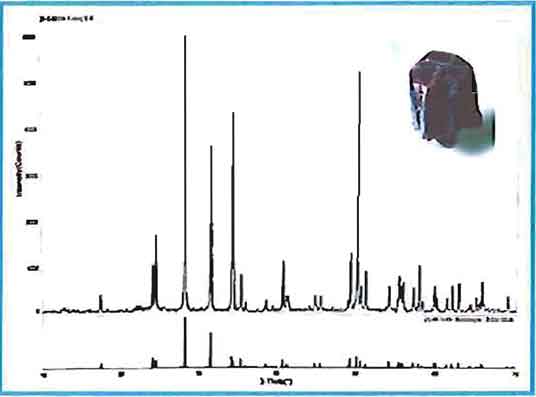 |
| Fig. 7.43. Baddeleyite crystal, associated with painite, and its XRD spectrum from Thurein Taung. |
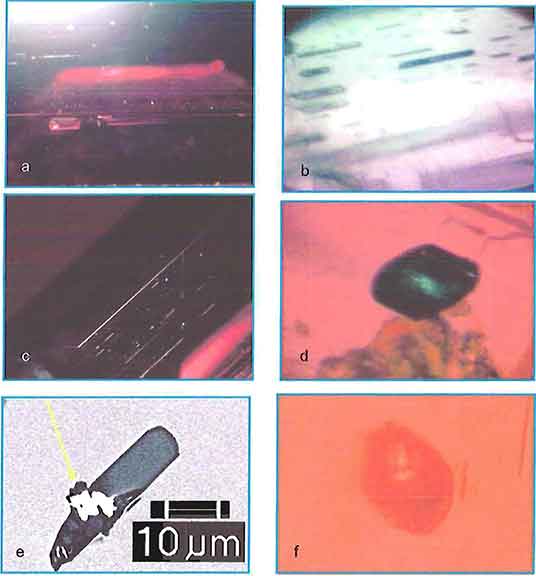 |
| Fig. 7.44. (a) Two-phase inclusion, transmitted light, 30 X; (b) rectangular shape liquid filled negative inclusions, transmitted light, 30 X ; (c) needle-like rutile inclusions, transmitted light, 30 X; (d) baddeleyite crystal inclusion in painite, transmitted light, 30 X ; (e) BSE image of srilankite inclusion in painite from Namya; (f) srilankite crystal inclusion in painite from Wet-loo, transmitted light, 30 X. |
Chapter VIII Summary and Conclusions
8.1. Objectives and Scope of the Research
- This research was carried out to contribute to the geological, petrographic, petrogenetic, petrochemical, geochronological and gemmological aspects of the various types of igneous rocks that occur in the northeastern part of the Mogok Stone Tract, covering the Mogok-Kyat-pyin, Bernard-Pyaung-gaung and On-dan areas. To fulfill these objectives, the distribution of the various igneous rock bodies were remapped, the microscopic petrography of the various igneous rock types was done, the chemical compositions of 15 igneous rock samples were analysed, the petrogenetic interpretations were made, the radiometric dating of four samples was done, and the important gemstones of igneous origin were studied and described.
8.2. Geological Features
- The Mogok Stone Tract is very famous not only for the finest rubies and spinels but also for gem quality sapphire, peridot, aquamarine, danburite, topaz, moonstone, etc. and some rare gemstones such as painite, poudretteite, etc.
- Mogok-Kyat-pyin area, lying in the northeastern part of the Mogok Stone Tract, is a mountainous region with two distinct valleys—Mogok Valley and Kyat-pyin Valley. The Mogok Valley is at the general elevation of 1150-1200 m above sea level; the Kyat-pyin Valley is a little higher than the Mogok Valley in elevation. Both valleys were formed by structural and lithologic controls; they are south-plunging synclinal valleys separated by an anticlinal ridge (Baw-padan Anticline). These two valleys contain a larger proportion of placer gemstones.
- On the basis of primarily field observations and petrographic data, and secondarily petrochemical and geochronological data, the geology and the rock sequence of the area are modified from some previous works (e.g., Iyer (1953), Myint Lwin Thein et al. (1990), Thet Tin Nyunt (2000), and Thuzar Aung (2003) ). Three new geological maps were prepared for the Mogok-Kyat-pyin, Bernard-Pyaung-gaung, and On-dan areas. Field observations indicate that most of the igneous bodies in the area have intrusive contacts with the surrounding Mogok metamorphics or other igneous rocks.
- The rock sequence of the major rock units established is (from older to younger): 1. Mogok metamorphics (metamorphosed Lower Paleozoic rock units-metamorphic age Late Oligocene); 2. Ultramafic and mafic rocks (Jurassic?); 3. Leucogranite (Early Oligocene); 4. Syenitic rocks (Late Oligocene); 5. Kabaing Granite (Middle Miocene); and 6. Pegmatites and aplites (Middle Miocene).
- It has been observed that the syenitic rocks and pegmatites are especially important for the formation of precious gemstones of the area.
8.3. Petrography
- On the basis of detailed microscopic observations, modal analyses. and normative calculations, the various igneous rocks types according to lUGS classification (2006) for a, b, d and Williams et al. classification (1982) for c are as follows:
- Ultramafic rocks: dunite, harzburgite, pyroxene peridotite, and hornblende peridotite
- Syenitic rocks: quartz syenite, alkali-feldspar syenite, nepheline syenite, alkalifelspar syenite pegmatite, and quartz monzonite
- Urtite series: urtite, ijolite, and jacupirangite
- Granitic rocks: augite-biotite granite, leucogranite and biotite microgranite(Kabaing Granite)
- Pegmatites and aplites
- The major pegmatite bodies at Sakhan-gyi and Pan-taw are found to be of complex type according to Kerkvoot classification (1995); and of rare-element class, beryl type according to Cerny classification (1991).
8.4. Petrochemistry and Interpretations
- It can be noted from Table 4.1 that the various rock types analysed generally have the common petrochemical characteristics of similar typical rock types. In general, it can be said that the modal compositions of the syenitic rocks, ultramafic and mafic rocks correspond to CIPW norms with biotite and hornblende.
- On the basis of petrogenetic interpretations (see Figs. 4.5 and 4.6), the igneous rocks of the area are mainly calc-alkaline and only partly alkaline. This is also evident from the bimodal distributions of the petrochemical data plots. The value of alkali-lime index (Peacock index) is 55 for the igneous rocks of the area, indicating the calcic to alkalic-calcic character in this area.
- In the normative Ab-Or-An diagram (Fig. 4.9), most of the plots of the granitic rocks fall in the granite field, and the urtite and mafic rocks fall in the tonalite field. However, the two groups may have belonged to two separate igneous events, because the igneous ages probably are different and there are no intermediate rock types present in the area.
- ACF diagram (Fig. 4.13) and some distinctive chemical properties of the granitic rocks of the area indicate that these granitic rocks are mostly S·type granites.
- In Fig. 4.18, assuming PH2O = Ptotal' the minimum PH2O indicated by the scattered points of granitic rocks are 2 kb for leucogranite and 5 kb for Kabaing Granite. The temperature-differentiation index diagram indicates that the liquidus temperatures could be 650°C for pegmatite, 680°C for leucogranite, 690°C for biotite microgranite, 700°C for augite-biotite granite, 700–720°C for syenitic rocks, 785°C for urtite series, 950°C for gabbro, and 1180°C for peridotite.
- In K2O mol. vs Na2O mol. variation diagram (Fig. 4.20), the plots of augite-biotite granite fall in the field of syn-kinematic granite, but leucogranite, biolile microgranite and pegmatite fall in the field of late-kinematic granite. It should be pointed out, however, that the radiometric age of the augite-biotite granite suggests a prekinematic origin rather than a syn-kinematic origin. (see Paragraph 24)
8.5. Petrogenesis
- The pre-kinematic origin of the augite-biotite granite as mentioned in Paragraph 14 is supported by the presence of pronounced secondary foliation in this rock.
- The low content of mafic minerals (less than 3%) in the leucogranite and the fairly low PH20 for the leucogranite as mentioned in Paragraph 13 suggest that the leucogranite originated as a fairly dry melt.
- According to the petrochemical data, it can be postulated that the granitic rocks of the area generally fall in the IAG+GAG+GGG field. However, in the Shand’s index diagram (Fig. 5.4), plots of the granitic rocks fall in the GGG (continental collision granite) field. In this case, the granitic rocks of the area may be regarded as continental collision granites. This conclusion generally agrees with that given in Paragraph 12.
- In the alkaline rocks of the area, the (Na2O+K2O)/Al2O3 ratio is less than 1; thus, according to Hyndman classification (1985), these alkaline rocks fall in the miaskitic type, i.e., not peralkaline.
- The origin of nepheline syenite as small irregular bodies in the marginal zones of Mogok marbles near the contact with leucogranite (as in the Thurein Taung area) or with syenite (as in the area northwest of On-dan) can be explained by the well-known limestone syntexis model. In this case, the local assimilation and desilication of alkali-feldspars in leucogranite or syenite in contact with marble would result in the formation of some nepheline and lime-silicate minerals.
- Similar to the process mentioned in Paragraph 19, the rocks of the urtite series may have been formed by the assimilation and desilication of the leucogranite or syenite in contact with mafic-rich marbles and lor mafic rocks, such as hornblendite. This kind of origin can be seen at the eastern slope of Thurein Taung and east of Kyauk-pyat-that.
- The ultramafic rocks occur as layered intrusions in garnet-biotite gneiss (probably older than Mogok metamorphics) in Bernard-Pyaung-gaung area. The layering character of these rocks indicates that there was gravity settling at various stages during the cooling of the basic magma. They may have intruded along some minor faults which appear to be secondary to the Momeik fault that lies only about one mile to the north. The ultramafic rocks of the area are considered to be not related to an ophiolite suite because of the absence of bedded chert, pillow lavas, basaltdiabase sheeted dyke swarms, and large-scale serpentinization.
- Field and petrochemical data suggest that the leucogranite and syenitic bodies intruded forcefully along a highly deformed zone roughly extending NE-SW. The depth of emplacement is estimated to range from katazone to mesozone. Kabaing Granite, which is a large microgranite body, intruded later at a shallower depth.
- The metamorphic and igneous history of the area may be as follows:
- Intrusions of ultramafic bodies into a possibly older metamorphic sequence in the Bernard-pyaung-gaung area possibly during Jurassic.
- Intrusions of augite-biotite granite probably during Early Cretaceous.
- Regional metamorphism of the Mogok metamorphics probably during Late Oligocene.
- Intrusions of leucogranite and syenitic rocks with limited contact metamorphism probably during Oligocene.
- Intrusions of Kabaing Granite during Middle Miocene.
- Injections of pegmatites and aplites during Middle Miocene.
8.6. Geochronology
- Radiometric dating of zircon in four samples by U-Th-Pb method using laser ablation inductively coupled mass spectrometry (LA ICP-MS) and super high-resolution ion microprobe (SHRIMP) techniques at University of Tasmania, Australia give the following results:
- Augite-biotite granite, Tayng-me Taung peak: 129.8± 8.2 Ma (Early Cretaceous).
- Leucogranite, Ohn-bin-ywe-htwet, east of Mogok: 32± 1 Ma (Early Oligocene).
- Foliated syenite, north of Ohn-gaing: 25 Ma (Late Oligocene).
- Painite from contact zone between leucogranite and marble, Wet-loo mine, west of Mogok: 16± 0.5 Ma (Middle Miocene).
- Three radiometric dates mentioned in some previous works should also be mentioned:
- Uranothorianite bearing pegmatite: 15 Ma
- Kabaing Granite: 16 Ma, 15.8± 1.1 Ma
8.7. Gemstones
- The important gemstones of mainly igneous origin, with reference to the rock types are:
- Pegmatites: aquamarine, topaz, danburite, amethyst, moonstone, zircon
- Syenite pegmatite: sapphire, zircon
- Urtite: sapphire
- Peridotite: peridot, enstatite e. Leucogranite (contact zone): painite
- The four most important gemstones of igneous origin are aquamarine, sapphire, peridot and painite. The important localities of their occurrences are:
- Aquamarine: at Sakhan-gyi in association with topaz, orthoclase, quartz, etc.
- Sapphire: at Thurein Taung and On-dan in association with spinel, schorl, etc.
- Peridot: at Mya-sein Taung and Zalat Taung in association with enstatite, talc, etc.
- Painite: at Wet-loo and Thurein Taung in association with baddeleyite, anatase, etc.
Appendix
The Appendix consists of twelve spectrographs contained in this PDF.
Thus conclude Chapters VII and VIII.
References follow.
References
Adams, E.D., 1926. A visit to the gem districts of Ceylon and Burma. Bull. Can. Inst. Min. Met. v. 166, pp. 213–246.
Barley, M.E, A.L. Pickard, Khin Zaw, P. Rak and M.G. Doyle, 2003. Jurassic to Miocene magmatism and metamorphism in the Mogok metamorphic belt and the Indian-Eurasia collision in Myanmar. Tectonics, v.22, no.3, pp. 1–11.
Bender, F. 1983. Geology of Burma. Gebruder Borntraeger, Berlin, 293 pp.
Bertrand, G, C. Rangin, H. Maluski, Tin Aung Han, Myint Thein, Ohn Myint, Win Maw and San Lwin, 1999. Cenozoic metamorphism along the Shan scarp (Myanmar): evidences for ductile shear along the Sagaing fault or the northward migration of the eastern Himalayan syntaxis. Geophysical Research Letters, v. 26, pp. 915–918.
Bertrand, G., C. Rangin, H. Mluski, H. Bellon and GIAC Scientific Party, 2001. Diachronous cooling along the Mogok Metamorphic Belt (Shan scarp, Myanmar): the trace of the northward migration of the Indian syntaxis. Journal of Asian Earth Sciences, v.19, pp. 649–659.
Brown, C.B. and J.W. Judd, 1896. The rubies of Burma and associated minerals; their mode of occurrence, origin and metamorphoses: a contribution to the history of corundum. Philosophical Transaction of the Royal Society of London. Series A, v. 187, pp. 151–228.
Brook, M., and N.J. Snelling, 1976. K/Ar and Rb/Sr age determinations on rocks and minerals from Burma. Inst. Geol. Sci., London, Isotope Geol. Unit Report 76/12, p.20.
Buddington, A.F., 1959. Granite emplacement with special reference to North America, Geol. Soc. Am. Bull., v. 70. pp. 671–747.
Cerny, P., 1991. Rare-element granitic pegmatite: regional to global environments and petrogenesis. Geosci. Can., v. 18, pt. 2, pp. 68–81.
Chappell, B.W. and A.J.R. White, 1974. Two contrasting granite types. Pacific Geol., v. 8, pp. 173–174.
Clegg, E.L.G. 1941. The Cretaceous and associated rocks of Burma. Mem. Geol. Surv. India, v. 74, pt.1, 101 pp.
Cobbing, E.J., P.E.J. Pitfield, O.P.E. Darbyshire and D.J.J. Mallick, 1992. The granites of the South-East Asian tin belt. Overseas Memoir, British Geological Survey, London, no. 10, 369 pp.
Fermor. L.L., 1932. The Mogok Stone Tract, Katha District. Rec. Geol. Surv. India, v. 65, pt. 1, pp. 80–86.
Hatch, F.H, A.K. Wells and M.K. Wells, 1961. Petrology of the igneous rocks, Thomas Murby, London, 514 pp.
Heron. A. M., 1937, Age of Mogok series, Rec. Geol. Surv. India, v. 72, pt. 1, pp. 62–64.
Hla Kyi, T. Themelis and Kyaw Thu, 2005. The pegmatitic gem deposits of Molo (Momeik) and Sakhan-gyi (Mogok). The Australian Gemmologist, v. 22, no. 7, pp. 303–309.
Hutchison, C.S., 1975. The norm, its variations, their calculation and relationships. Sch. Min. Pet., Mitt., v. 55, pp. 243–256.
Hyndman, D.W, 1985. Petrology of igneous and metamorphic rocks. New York, McGraw-Hill. 2nd edt., 786 pp.
Irvine, T.N. and W.R.A. Barager, 1971. A guide to the chemical classification of the common volcanic rocks. Can. Jour. Earth Sci., v. 8, pp. 523–548.
Iyer, L.A.N., 1953. The geology and gemstones of the Mogok Stone Tract, Burma. Mem. Geol. Surv. India, v. 82, pp. 100.
Kerkvoort, G.V., 1995. Rare metal granitic pegmatites. Unpublished B.Sc. Hons. Thesis, University of Tasmania, Australia, 70 pp.
Khin Zaw, 1986. Geological, petrological, and geochemical characteristics of granitoid rocks in Burma: with special reference to the emplacement of W-Sn mineralisation and their global tectonic implications. Unpublished research paper.
Khin Zaw, 1998. Geological evolution of selected granitic pegmatites in Myanmar (Burma): constraints from regional setting, lithology, and fluid-inclusion studies. International Geology Review, v. 40, pp. 647–662.
La Touche, T.H.D., 1913. Geology of the northern Shan States. Mem. Geol. Surv. India, v. 39, pt. 2, 379 pp.
Maniar, P.D., and P.M. Piccoli, 1989. Tectonic discrimination of granitoids. Geol. Soc. Am. Bull., v. 101, pp. 635–643.
Marmo, A., 1956. On the emplacement of granites. Amer. Jour. of Sci., v. 254, pp. 479–492.
Maung Thein, 2000. Summary of the geological history of Myanmar. Unpublished paper, p.8.
Metcalfe, I., 1998. Origin and assembly of South-East Asia continental terranes. In: Audley Charles, M.G., Hallam, A. (Eds.), Gondwana and Tethys, Special publication Geological Society of London, v. 37, pp. 101–118.
Metcalfe, I., 2000. The Bentong-Raub suture zone. Journal of Southeast Asian Earth Sciences, v. 18, pp. 691–721.
Mitchell, A.H.G., 1977. Tectonic setting for emplacement of Southeast Asia Tin granites. Geological Society of London, v. 141, pp. 123–140.
Mitchell, A.H.G., 1992. Late Permian-Mesozoic events and the Mergui Group nappe in Myanmar and Thailand. Jour. of SE Asia Earth Sciences, v. 7, pp. 165–178.
Mitchell, A.H.G., 1993. Cretaceous-Cenzoic tectonic event in western Myanmar (Burma)—Assam region: Jour. of the Geol. Soc. London, v. 150, pp. 1089–1102.
Mitchell, A.H.G., C.A. Ausa, L. Deiparine, Tin Hlaing, Nyunt Htay and Aung Khine, 2004. The Modi Taung-Nankwe gold district, Slate Belt, central Myanmar: mesothermal veins in a Mesozoic orogen. Journal of Asian Earth Sciences, v. 23, pp. 231–341.
Mitchell, A.H.G., Myint Thein Htay, Kyaw Min Htun, Myint Naing Win, Thura Oo and Tin Hlaing, 2006. Rock relationships in the Mogok metamorphic belt, Tatkon to Mandalay, central Myanmar. Jour. of Asian Earth Sciences. doi:10.1016/j.jseaes.2006.05.009, pp.1–20.
Myint Lwin Thein, Ohn Myint, Sun Kyi and Phone Nyunt Win, 1990. Geology and stratigraphy of the metamorphosed Early Paleozoic rocks of the Mogok-Thabeikkyin-Singu-Madaya areas. Unpublished staff report, no. 98, A.G.D., Y.U., p.24.
O’connor, J.T., 1965. Classification of quartz-rich igneous rocks based on feldspar ratios. U.S.G.S. Prof. Paper. 525B, pp. 79–84.
Piwinskii, and P.J. Wyllie, 1970. Experimental studies of igneous rock series: felsic body suite from the Neddle point pluton, Wallowa Batholith, Oregon. Jour. Geol. v. 78, pp. 52–76.
Ridd, M.F., 1971. South-East Asia as a part of Gondwana land. Nature, v. 234, pp. 531–533.
Rossman, G.R., Saw Naung Oo, G.E. Harlow and J. Hunt, 2005. A second source in Myanmar and metasomatic origins. Goldschmidt Conference Abstract, Geochemistry of Gem Deposits Sec., pp. 278–279.
Searle, D.L. and Ba Than Haq, 1964. The Mogok belt of Burma and its relationship to the Himalayan orogeny. in Int. Geol. Cong., Twenty-Second Sec., India, Himalayan and Alpine orogeny, Sec. 11, pp. 132–161.
Sein Myint, Than Naing and Soe Nyunt Swe, 1979. Satellite imagery interpretation of major lineaments in part of northeastern Burma. Contribution to Burmese Geology, v. 1, no. 1. pp. 20–25.
Smirnov, V.I., 1976. Geology of mineral deposits. MIR Publishers, Moscow, 520 pp.
Sutherland, F.L., D. Schwarrz, E.A. Jobbins, R.R. Coenraads and G. Webb, 1998. Distinctive gem corundum suites from discrete basalt fields: a comparative study of Barrington, Australia, and West Pailin, Cambodia gem fields. Journal of Gemmology, v. 26, pp. 65–85.
Sylvester, P. J., 1989. Post-collision alkaline granites. Jour. of Geol., v. 97, pp. 261–280.
Thet Tin Nyunt, 2000. Mineralogical and petrological studies of Bemard-Pyaunggaung area, Mogok Township, Mandalay Division. Unpublished M.Sc. Thesis, University of Yangon, 184 pp.
Thuzar Aung, 2003. Petrology and Gemstones of Ondan and its Environs, Mogok Township, Mandalay Division. Unpublished M.Res. Thesis, University of Yangon, 90 pp.
Tuttle, O. F., and N.L. Bowen, 1958. Origin of granite in the light of experimental studies in the system NaAISip8-KAISiP8-Si02-H20. In: Hyundman, D.W., 1985. Petrology of igneous and metamorphic rocks. New York, McGraw-Hill. 2nd edt., 786 pp.
United Nations, 1978. Geology and exploration geochemistry of the Shan scarps area, east of Kyaukse, Thazi and Tatkon, central Burma. Technical Report. UN/BUR 721002, no. 3, United Nations Development Programme, New York.
Washington, H.S., 1917; Chemical analyses of igneous rocks published from 1884 to 1913, inclusive. U.S. Geol. Survey Prof. Paper, no. 99, pp. 9–1201.
Wiebe, R.A., 1974. Differentiation in layered diorite intrusions, Ingonish, Nova Scotia. Jour. Geol., v. 82, pp. 731–750.
Williams. H., F.J. Turner and C.M. Gilbert, 1982. Petrography; an introduction of the study of rocks in thin section. 2nd ed. W.H. Freeman and Co., San Francisco, 626 pp.
Win Naing, 2001. Tertiary deformation patterns of the northeastern part of Myanmar: structural and microfabric evidences from the Mogok-Momeik area. Unpublished M.Res. Thesis, Dept. of Geol., University of Yangon 198 pp.
Wright, J.B., 1969. A simple alkalinity ratio and its application to questions of non-orogenic granite gneiss. Geol. Mag., v. 106, pp. 523–548.
